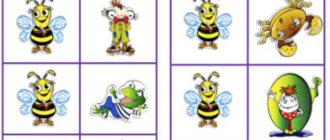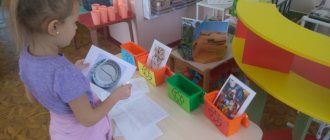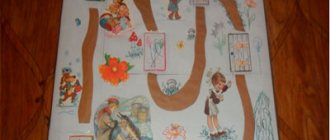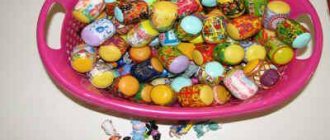Middle group. Junior preschool age. Children 4 - 5 years old
Didactic board game for children 3–5 years old according to FEMP “Numbers, Counting” Didactic board game “Numbers.
Account" Material : Playing field with numbers from 1 to 5, five cards with circles in quantities from one to five. Purpose of the game : To consolidate the ability to distinguish the number of objects on a card in quantities from one to five.
Learn to distinguish... Didactic manual on mathematics for children of primary preschool age “Pyramid-playing game”
The purpose of the didactic manual Generalization of acquired knowledge on FEMP Objectives of the didactic manual Educational : to consolidate the ability to count objects within 3; consolidate the ability to distinguish and correctly name geometric shapes (circle, square, triangle)
; learn to relate...
Do-it-yourself didactic manual for teaching numeracy in kindergarten
Do-it-yourself didactic mathematical manual for preschoolers
Master class on the production of the didactic manual “Fun Counting” for individual work with preschoolers
Author : Natalya Evgenievna Khokhlova Position: teacher-defectologist Place of work: MKDOU No. 22, Miass, Chelyabinsk region Description: master class on the production of the didactic manual “Fun Counting” for individual work with preschoolers on the formation of elementary mathematical concepts. Purpose of the material: for preschool teachers and caring parents. Goal: Production of a didactic manual “Funny Counting” for individual work with preschoolers. Objectives: - learn to create teaching aids with your own hands; - develop creativity. One of the main areas of preschool education is mathematics. “A child’s element is play,” so the main principle is to teach while playing. Teaching mathematics in a playful way develops and shapes the child’s cognitive interest. To make the teaching aid “Merry Counting” we will need materials: White cardboard; Scissors; Glue; Adhesive tape.
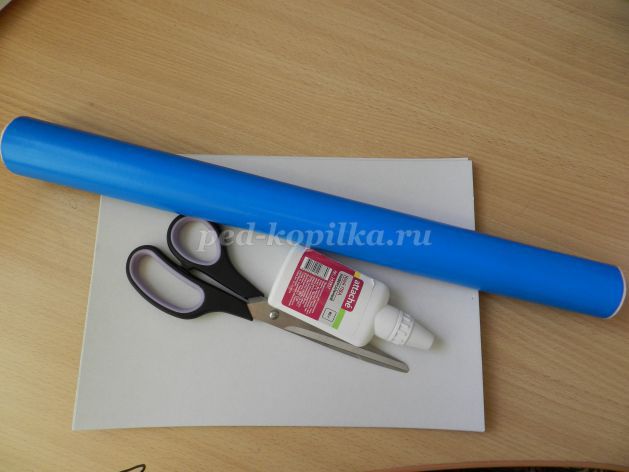
And so do the pictures. I made a blank from pictures taken from the Internet and printed them on a color printer. I fit 4 rows of pictures on one A4 sheet. Dimensions of one row: height 4.5 cm, width (length) 28 cm. Each row contains 10 pictures. I will be happy to share my preparations with you. We cut the printed blanks into strips along the lines.
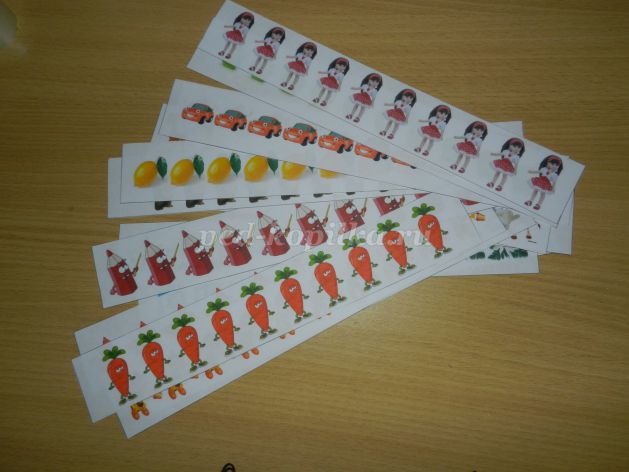
We make the same blanks (strips) from cardboard measuring 4.5 cm * 28 cm). And in addition to each workpiece, we will need two small strips measuring 0.7 cm * 28 cm.
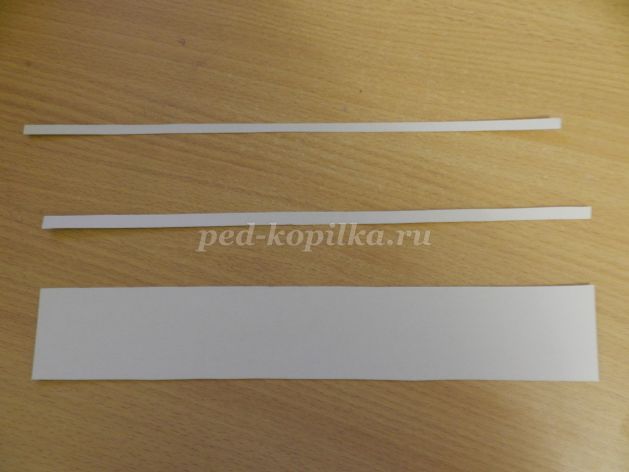
Next, use glue to glue our row of pictures onto the cardboard blank.
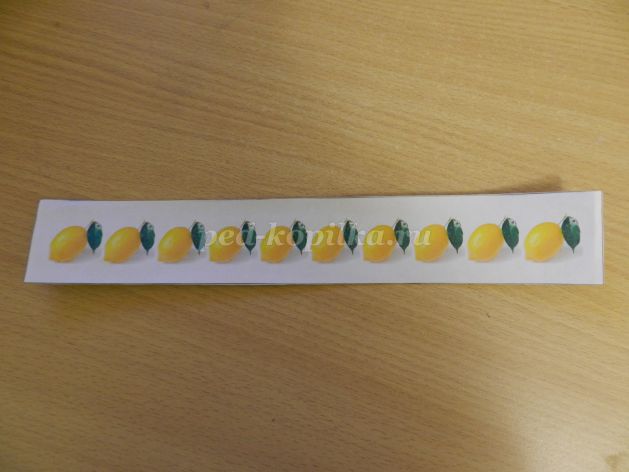
If you have a sufficient number of pictures, from magazines, unnecessary books, then you can cut them out and paste them on cardboard, then you don’t need to print the pictures. Next we need a self-adhesive film, which can be of any color. Cut a strip of self-adhesive a little wider than our narrowest strip.

We glue a narrow cardboard strip along the very edge of the self-adhesive, leaving the adhesive part of the film open.
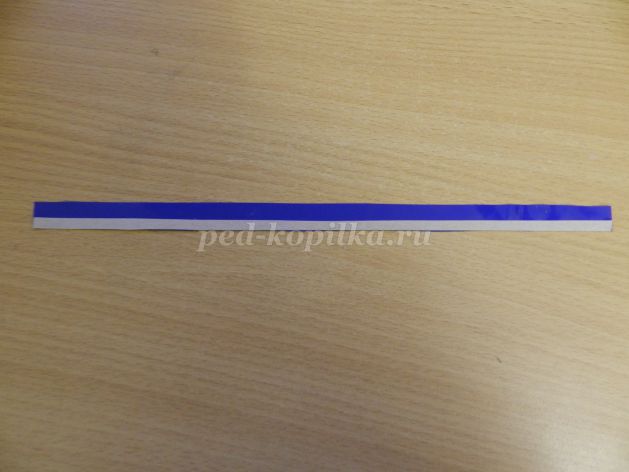
Then we take our wide strip with the picture pasted on it and place it face down, aligning the edges of the narrow and wide strips, also leaving the adhesive edge of the film open.
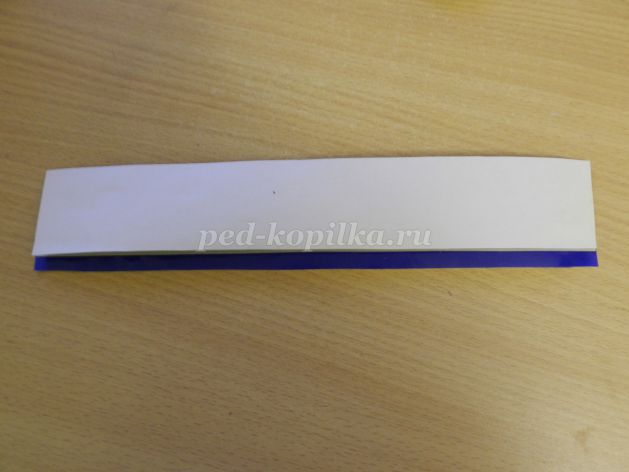
After the edges of the strips are aligned, we bend the adhesive edge of the film, thereby gluing the narrow and wide strips, turn it over and see what we got.
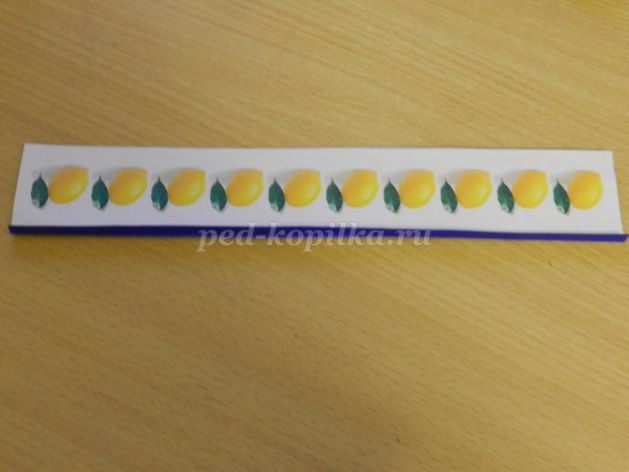
We process the second edge of the wide strip in the same way. Next, we cover with self-adhesive film the edge of the wide strip where the counting of objects will begin.
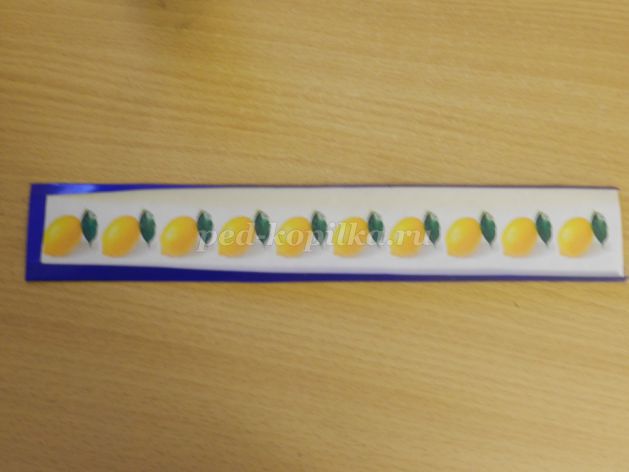
Cut a small strip of cardboard or any paper. Size height 4.5 cm, width 0.7 cm.

We put this strip under our sides
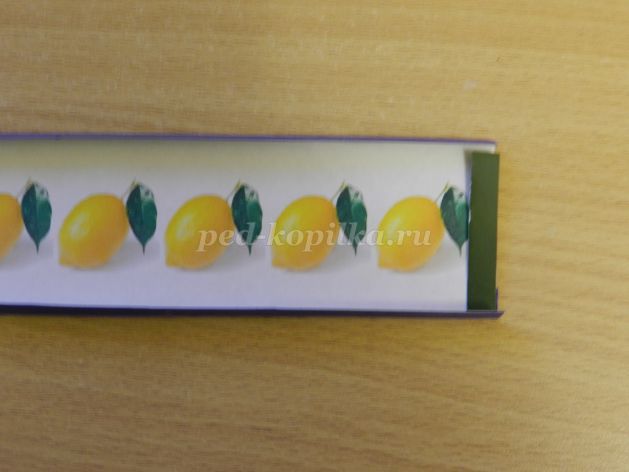
And glue a strip of self-adhesive film of the same size on top.
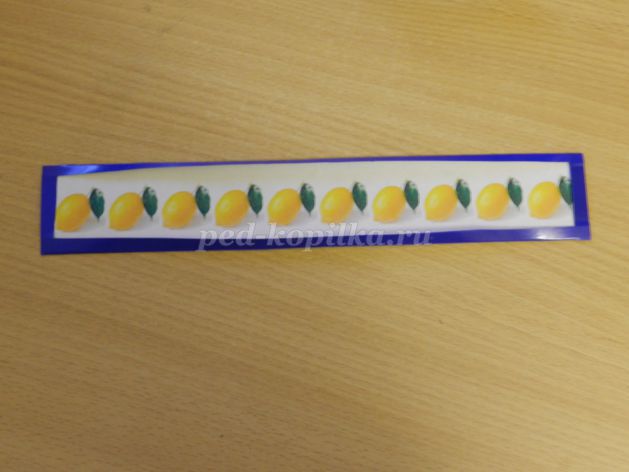
This needs to be done in such a way that we can insert a “slide” strip on this side of the card. Now our card does not look very aesthetically pleasing due to the fact that the narrow strips along the edge of the card do not fit tightly to the base and are puffy. All this can be corrected after all the cards are ready by placing them under a press.
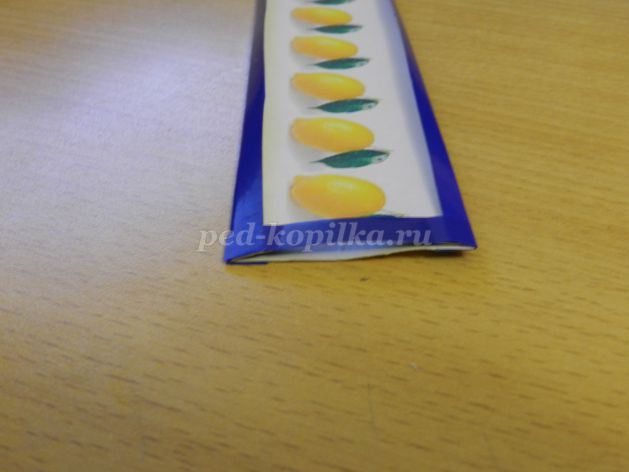
Next, cut out the “engine” strip from the cardboard. It should be a couple of millimeters smaller in height than the manufactured card, and a couple of centimeters longer in length.
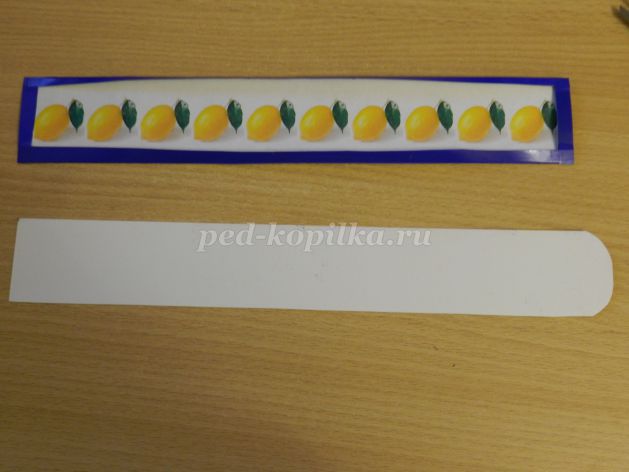
We insert the “engine” strip into the manufactured card and the card is completely ready.
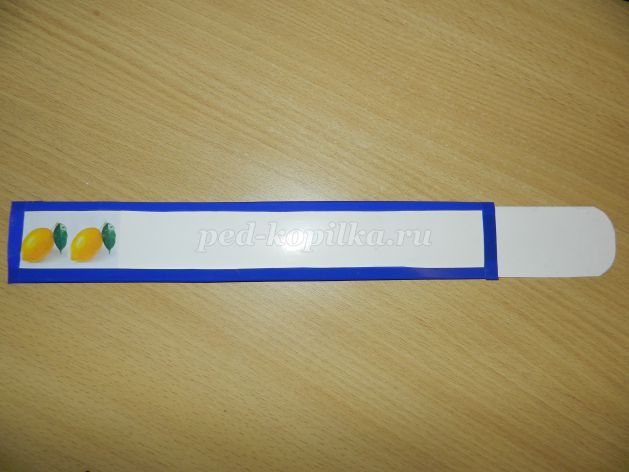
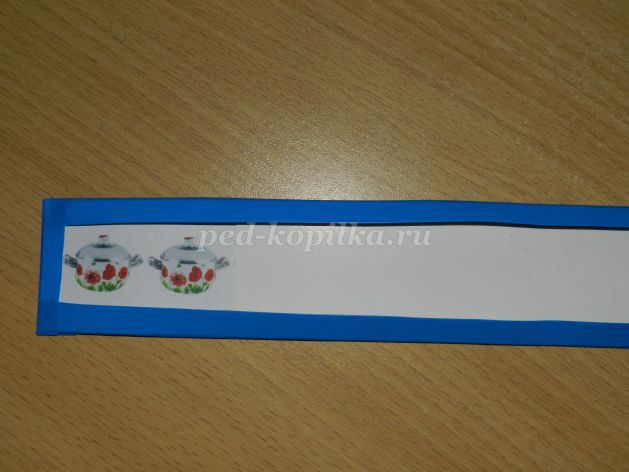
Or the use of the words one-one-one, two-two; One apple – two apples, etc.; You can count using an adjective - one green apple, etc.
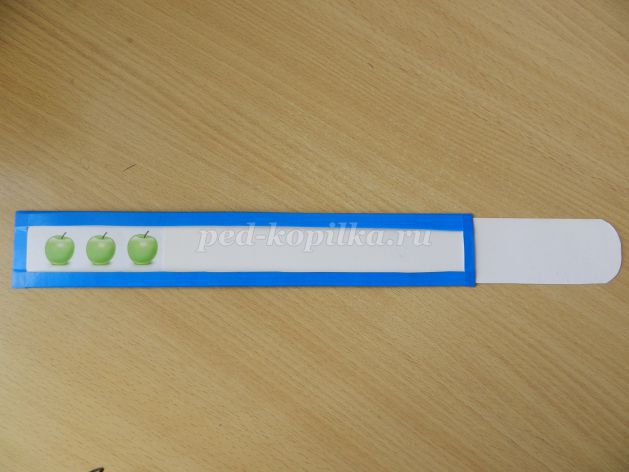
Cards can be made using pictures corresponding to the lexical topic of the week.
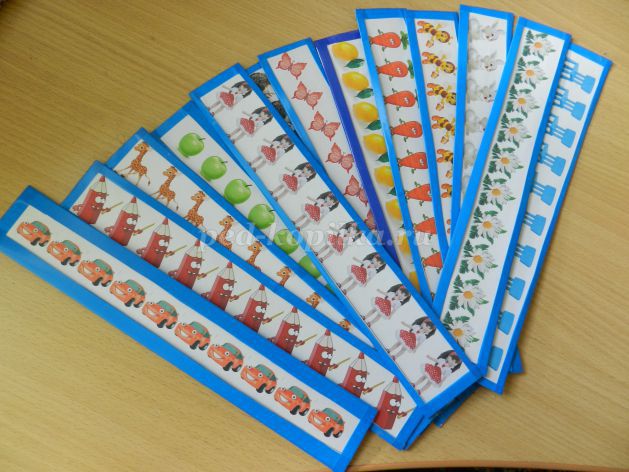
If desired, you can make the required number of cards to work with the subgroup. I hope that this teaching aid will be a good help to you and your children. I wish you creative success!
We recommend watching:
Do-it-yourself multifunctional game aid for preschoolers Do-it-yourself didactic aid for younger preschoolers Do-it-yourself didactic aid for kindergarten Do-it-yourself didactic aid “Paired Pictures” for kindergarten
Similar articles:
Game layout for children 4-7 years old “My City”
Multifunctional teaching aid for children 5-6-7 years old
Do-it-yourself manual for developing fine motor skills
Interactive educational poster “Fun Math”
Ekaterina Kladova
Interactive educational poster “Fun Math”
Goal: to consolidate children’s knowledge of the material covered on FEMP
Tasks:
Educational:
1. Repeat counting within 5, use in speech.
2. To develop children’s ability to distinguish objects by size and designate them with the words high - low, long - short, wide - narrow.
3. To develop children’s ability to distinguish and correctly name geometric shapes and select according to a given characteristic.
Educational:
1. Develop attention, memory, thinking, active vocabulary.
2. Develop finger motor skills.
Educational:
1. Develop an interest in joint activities with adults and peers.
2. To develop the ability to listen and hear the teacher, to act according to the verbal instructions of an adult.
Age: for children of primary preschool age.
The material will be useful:
Teachers of preschool educational institutions
Parents of preschool children.
Long weekends provide an opportunity for children and parents to spend a lot of time together. I would like to bring to your attention an interactive manual for preschool children (middle group)
according to FEMP.
teaching methods are difficult to imagine without multimedia interactive technologies that allow the use of text, graphics, audio, and video. These opportunities significantly expand the scope of application of computer technology in the educational process. Visual and sound accompaniment help to activate the imaginative thinking of children of primary preschool age, which contributes to a more holistic perception of the material and improves the quality of education in the pedagogical process.
The interactive poster is primarily designed to provide a high level of visibility of the educational process. K. D. Ushinsky, revealing the advantages of visual learning , noted that the child “. thinks in forms, colors, sounds"
.
Interactive poster “ Fun math for kids ”
designed for children of primary preschool age (junior group, educational area - cognitive development
(FEMP)
in the Power Point environment and made using the
“single screen”
, which allows you to visually perceive
the poster as one slide, without noticing the transitions between them. This methodological development can be used to review the material or a final lesson on the formation of elementary mathematical concepts ... The poster consists of several slides. The number of slides varies depending on the number of objects presented on the poster plus the title slide and slides with test tasks. The transition between slides is done by clicking on the image of one from objects through hyperlinks. It is possible to end the slide show at any time by clicking on the button at the top. In the poster “
Fun mathematics for kids " , by clicking on the topic we need (geometric shapes, magnitude, counting), we will see tasks for children who they can do it on their own: find an extra object, use the concepts of
“more-less”
,
“longer-shorter”
,
“wider-narrower”
,
“many-one”
.
By following the hyperlink “geometric shapes”
, we will see pictures where we need to find objects similar to geometric shapes.
If children choose the correct answer, the picture becomes transparent, and if the picture is redundant, it disappears. Having followed the hyperlink “magnitude”
and
“counting”
, children use the concepts already familiar to them:
“more-less”
,
“longer-shorter”
,
“wider-narrower”
,
“many-one”
.
They only need to choose one picture. If the last task is answered correctly, the user goes to a slide with topics, after which he can complete the work, or continue interacting with the poster .
Our students enjoy working with interactive aids . Interaction with them arouses keen interest and promotes the development of cognitive activity.
